You may not find this terribly rewarding unless you're included here, so this is a good time for casual and random browsers to turn back before they get too caught up in the sweep and majesty of the proceedings and can't let go.
The plan is to luxuriate for twelve days in Viterbo, with enthusiastic sight-seeing in the region, and a few days tacked onto either side of that for getting there and back.
The Villa Farnese in Caprarola

Bright and sort of early, we're off for Caprarola, 29 November 2016.
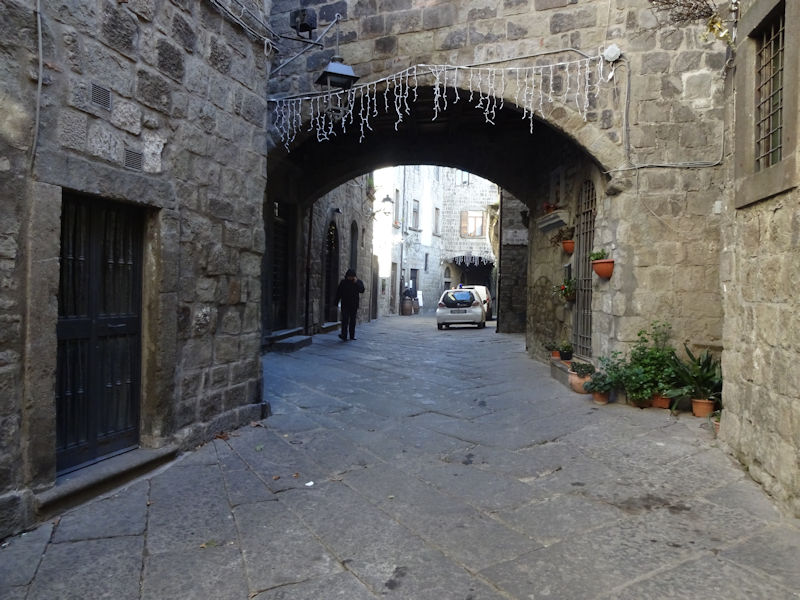
A chilly walk to the carpark outside the city walls of Viterbo

We're stopping in briefly to make a dinner reservation at Lo Scarfano (under the awning) in the Via San Pellegrino.
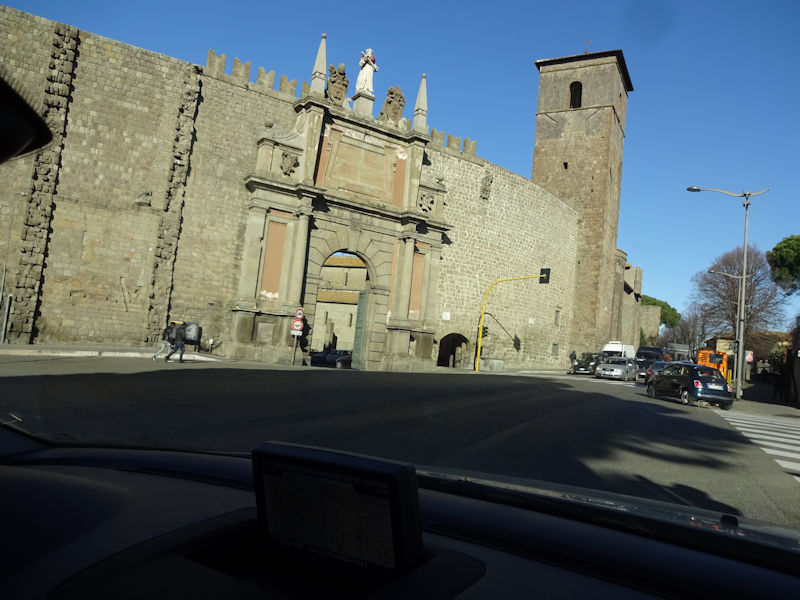
Leaving Viterbo past the Porta Romana, and turning south, proceeding . . .

. . . ten kilometres to the small volcanic caldera Lago di Vico in the Monti Cimini, or Cimini Hills, 5km across at its greatest extent
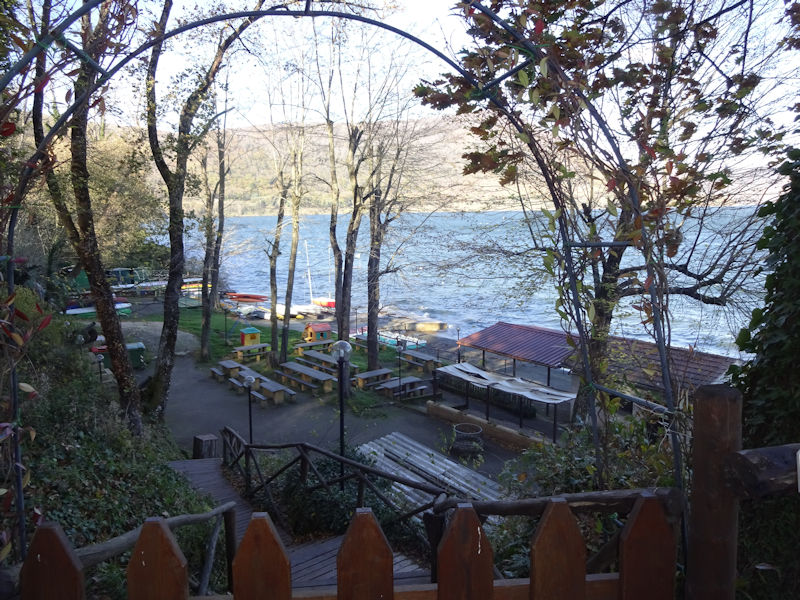
No crowds on a cold and windy November day

Just 2km east of the lake, this is the small town of Caprarole, current population of about 5,000, grown from a country estate acquired by the Farnese family in 1504.

The main street of Caprarola, looking up the hill at the Villa Farnese

There it is. The Farnese family are datable from the 980s, and its soldiers made names for themselves during the 12th and 13th centuries as commanders against Normans, Hohenstaufen imperialists, and assorted local Ghibellines, always on the Guelph side assisting whomever was pope at the time. They particularly distinguished themselves by helping Cardinal Albornoz on his punitive papal missions to the region in the 1350s and '60s, and came to be a leading family in the Tuscia territory (northern Lazio and southern Tuscany) in the 15th century.

The family's political prominence was assured when the famously beautiful Giulia Farnese, already married to an Orsini, became the mistress of Pope Alexander VI at the age of 19 (rooming with his daughter Lucrezia Borgia). She was able to get the Pope to name her brother Alessandro a Cardinal at the age of 25, which he was subsequently able to leverage into his own election as Pope Paul III in 1534, from which he was able to ensure that all other family members could have any high offices they might wish (like his grandson Alessandro, who was made a Cardinal a few weeks later in 1534, at the age of 14).
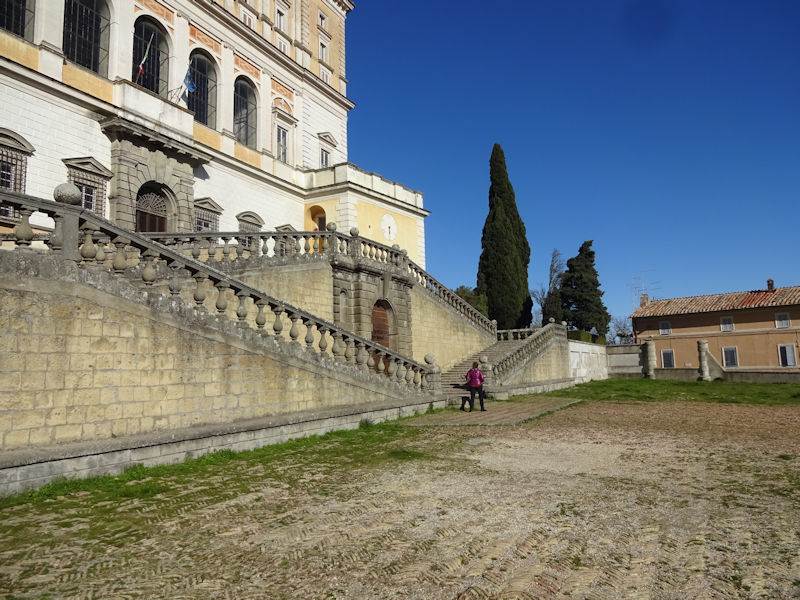
In 1504, Cardinal Alessandro, having aquired the Caprarola estate and aware of the uncertainties of the times, hired Antonio da Sangallo the Younger and Baldassare Peruzzi (who built the Chigi palace called the Villa Farnesina in Trastevere, Rome, a few years later) to build him a fine Renaissance fortified castle. They designed a pentagonal fortress with newly-modern corner bastions, and work was well underway but had languished by the time of the Pope's death in 1549.
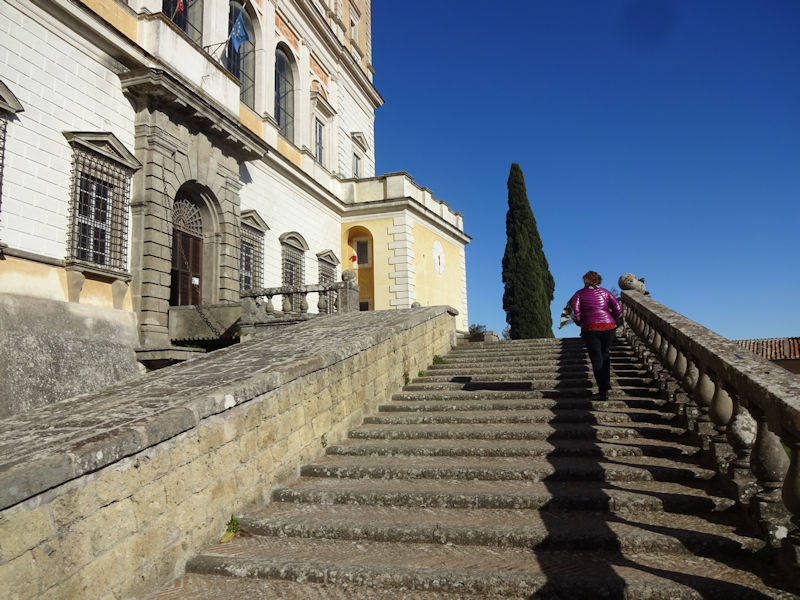
In 1556, Cardinal Alessandro, grandson of the Pope, revived the project and contracted Giacomo Barozzi da Vignola to adapt the designs and resume the work in a more modern Renaissance/Mannerist residential style. Work was begun in 1559 and until his death in 1573 Vignola managed this project and the building of the unfinished Palazzo Farnese in Piacenza for the Cardinal's brother Ottavio, the 2nd Duke of Piacenza and Parma (their father, the Pope's rowdy illegitimate son Pier Luigi, had been granted the dukedom in 1546 and been assassinated a year later).
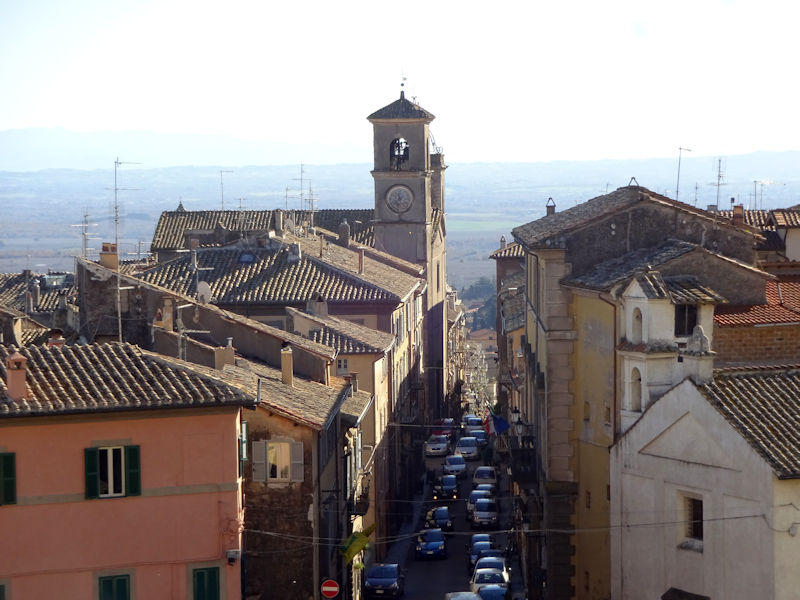
From the broad terrace of the Villa Farnese looking down the high street of Caprarola

A very nice glassed-in loggia, and higher stories with tiny windows for the staff and servants

The receiving room on the ground floor, originally a guards room, facing the ticket office. The picture on the left wall shows the Siege of Malta in 1565.

The rare circular courtyard within the pentagonal frame of the Villa . . .
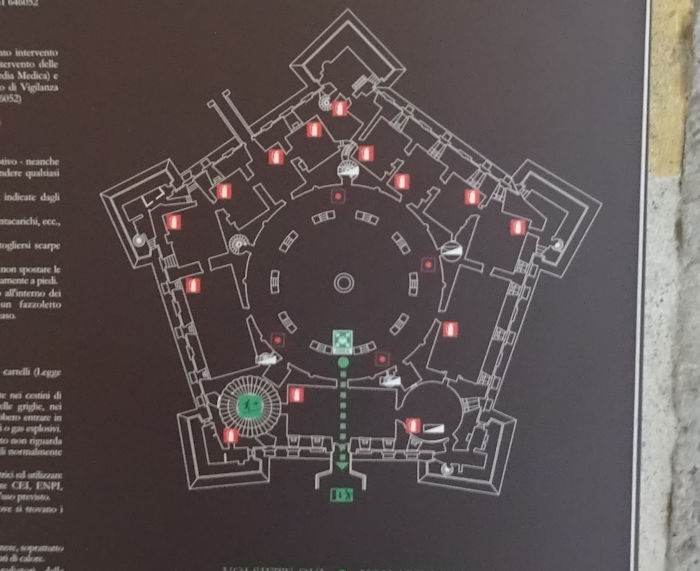
. . . like this. (The red squares are fire extinguishers.)

The ambulatory corridor around the circular courtyard
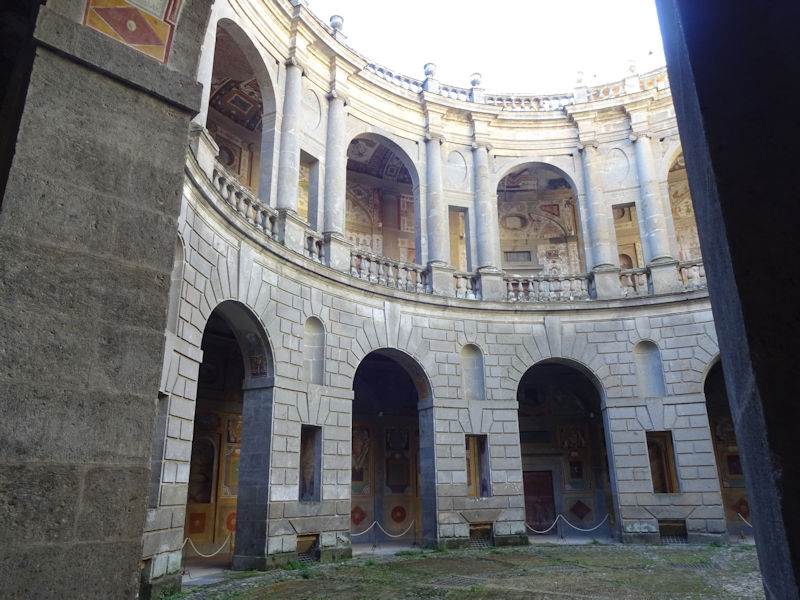
We're on the ground floor of the villa itself, but the basement below in the foundations houses guardrooms and other utilities, as well as a formal carriage entrance for fancy guests.
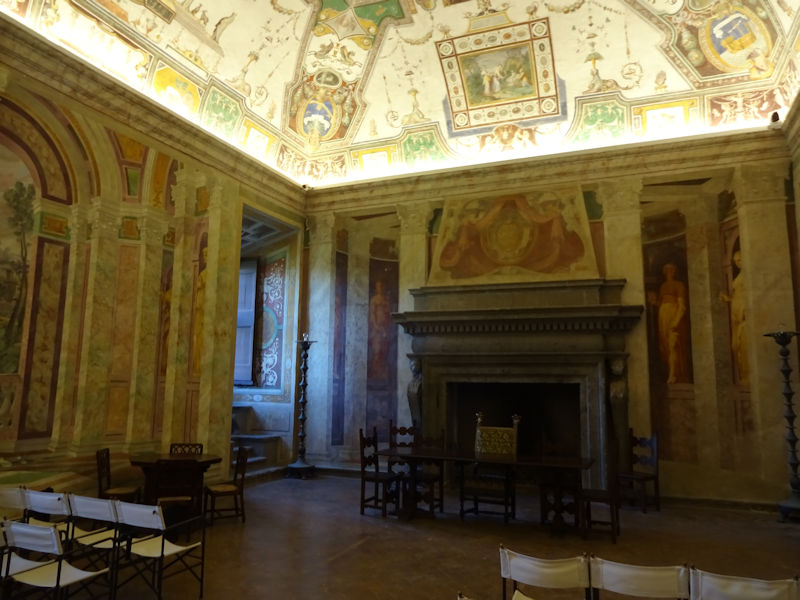
Not an inch has escaped frescoing.
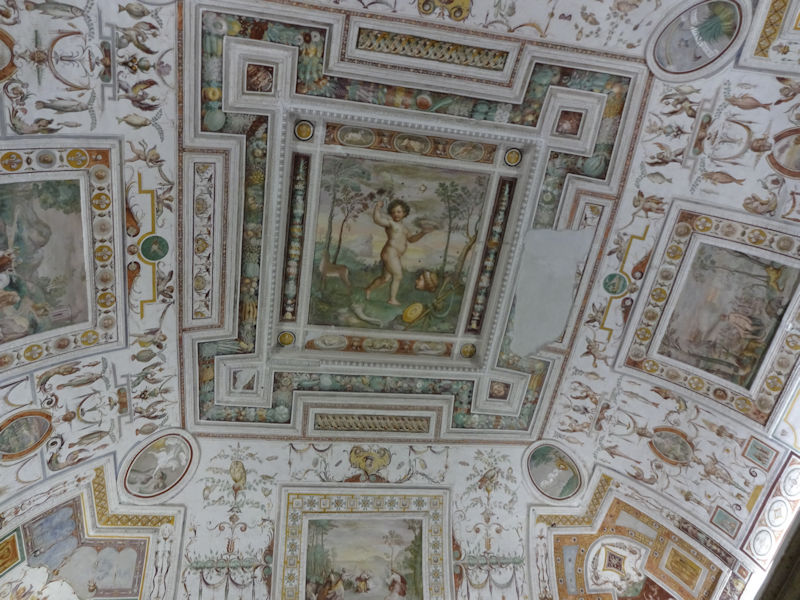
(Perhaps an acquired taste.)
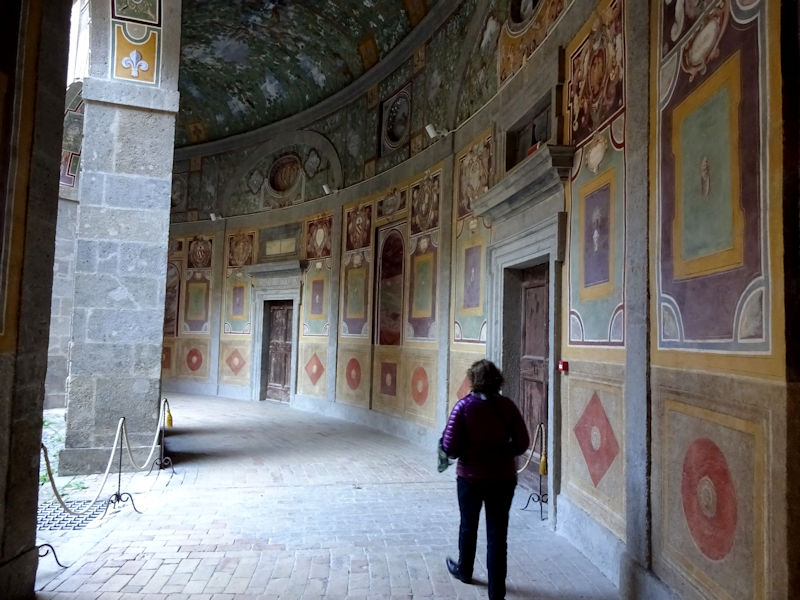
The ground floor, divided into the Summer and the Winter Apartments (on either side of the building) -- these include reception halls as well as private rooms for visiting VIPs, whilst the Cardinal himself had the upper floor to himself (and whomever).

Two levels of porticoes on the ground floor and the piano nobile above -- there are two higher stories as well, for extended family, noble hangers-on, and guests (the "Knights' Floor"), and their servants (the "Grooms' Floor"), but they are set back so as not to disturb the grand symmetries of this view.
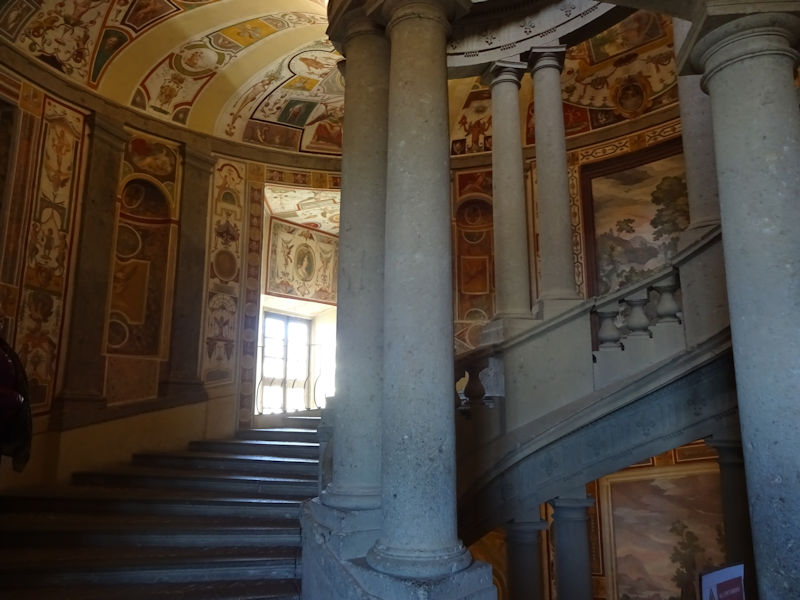
The Scala Regia or Royal Staircase leading up to the first floor, or piano nobile

Up we go
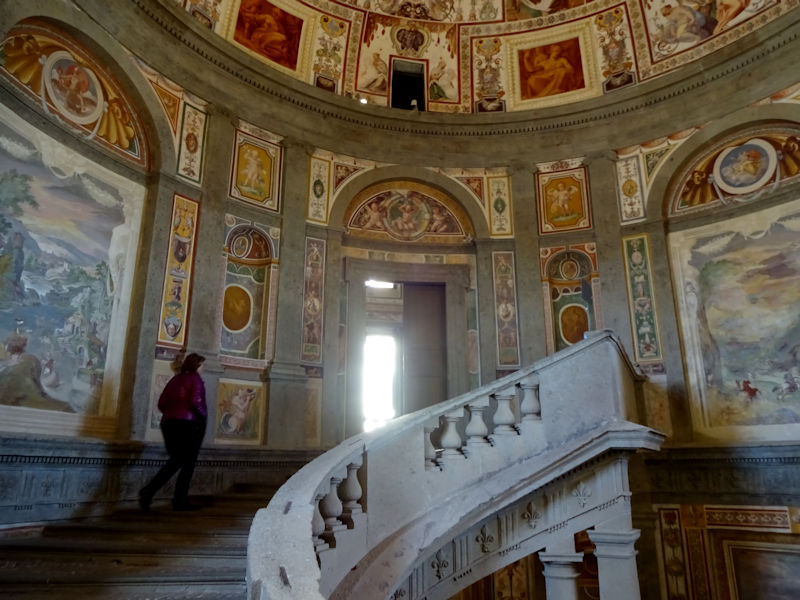
And still up

The dome of the staircase
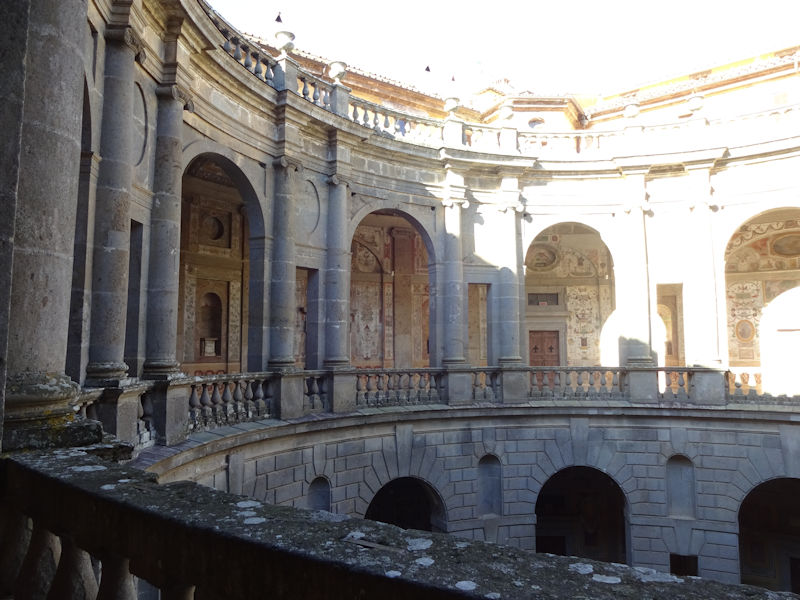
The courtyard below and ambulatory of the first floor
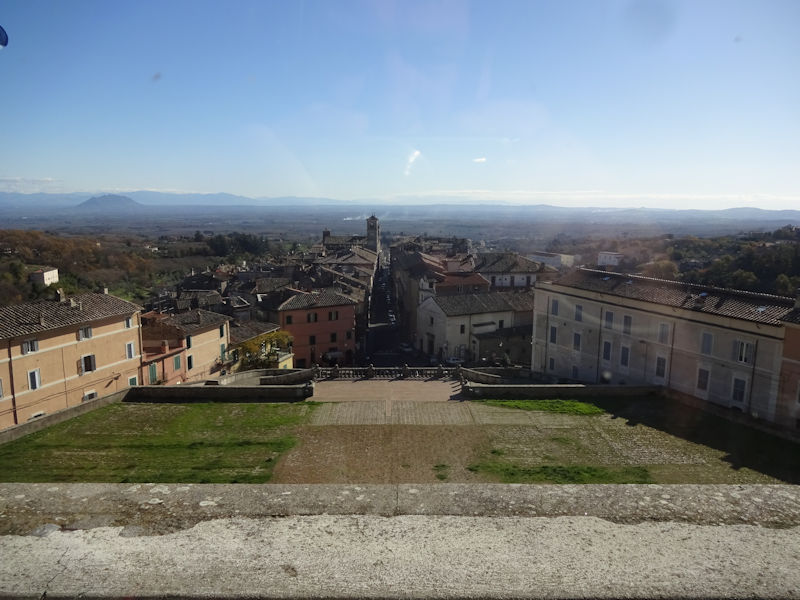
The view from the Hercules Room, the loggia on the first floor overlooking the town, originally used as a summer dining room but now glassed in

Frescoes round the walls illustrate various properties owned by the Farnese family in their heydey -- this one shows Parma . . .
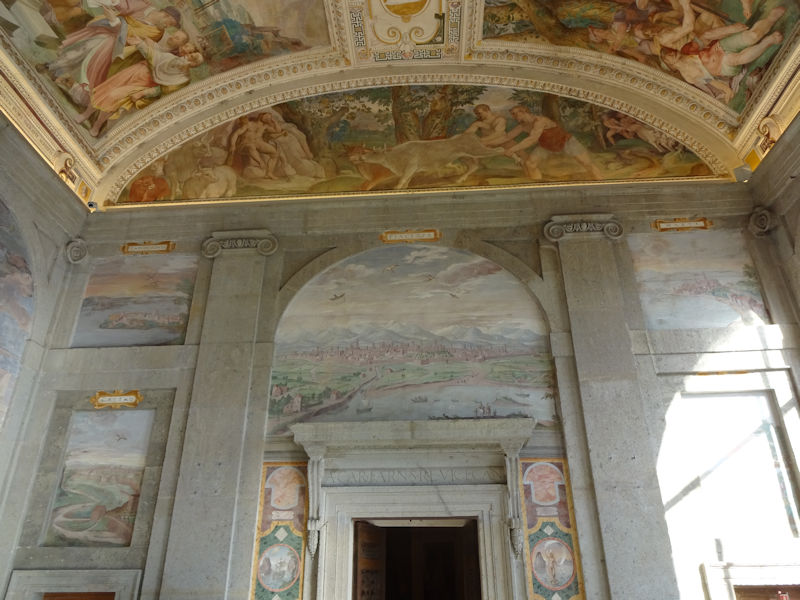
. . . and this one shows Piacenza. There are several more around the room, all executed in 1572-73.

A rustic fountain, once much prized for the effect of coolness it conveyed to the room. Errrm.

This is the round chapel, with decoration by Taddeo and then Federico Zuccari (who came to England in 1574 to paint the Earl of Leicester with Queen Elizabeth; also portraits of Mary Queen of Scots and Sir Francis Walsingham, a sad irony there, as well as other Elizabethan luminaries).
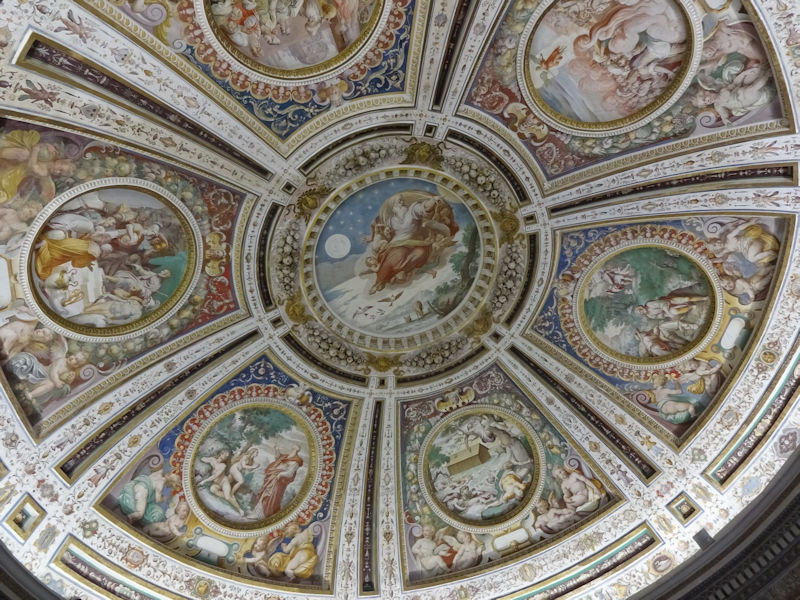
God and Biblical tales on the chapel ceiling

Now we're in the Room of the Fasti Farnesiani or Farnese High Points -- frescoes all round the walls, most of them also by the Zuccari brothers, a fabulous collection of poignant illustrations for the history buff. This one commemorates Pope Paul III marrying in 1538 his grandson Ottavio, at that time Lord of Camerino and later Duke of Parma, to the formidable Margaret of Austria, the Emperor Charles V's illegitimate daughter, who served ably for many years as the Governor of the Spanish Netherlands. The likenesses are generally good, except that the bride and groom were respectively 15 and 14 at the time.
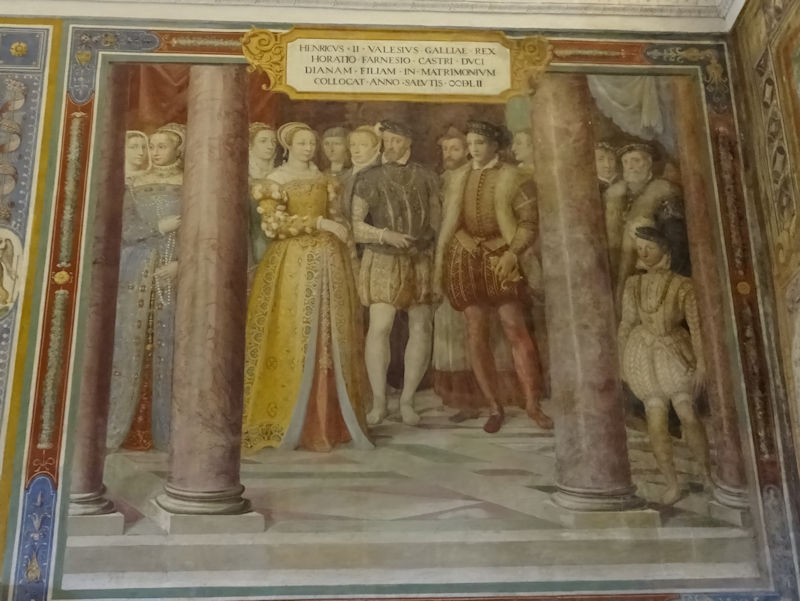
The marriage of Diane de France, illegitimate daughter of King Henri II, to Orazio Farnese, Duke of Castro, Cardinal Alessandro's youngest brother, in 1552. He was killed in battle the next year; Diane lived into her eighties and supervised the education of the young King Louis XIII in the next century.
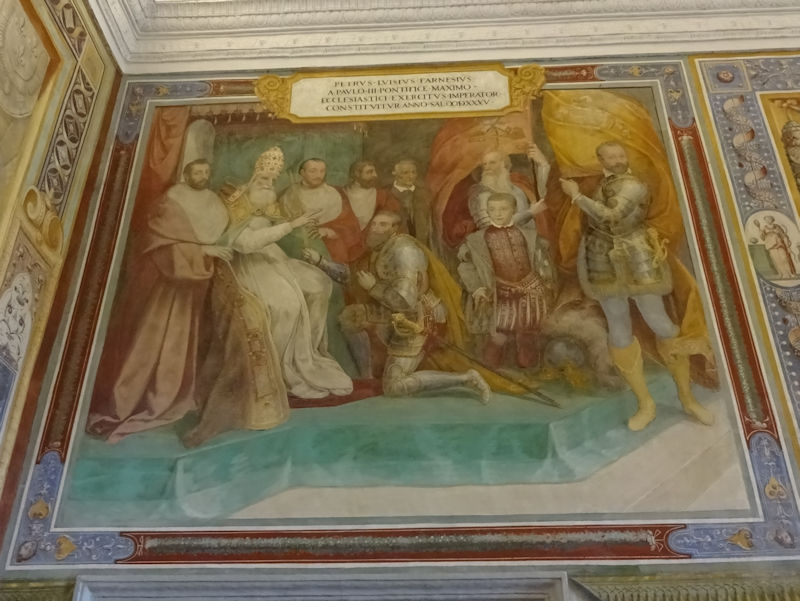
Pope Paul III appointing his illegitimate son Pier Luigi to the military position of Captain General of the Church, 1537 (though the legend seems to say 1535)

In 1540, Cardinal Alessandro, as the 20-year-old Papal Legate, brokered a peace treaty between King Francis I of France and the Holy Roman Emperor Charles V concerning responses to the spread of Lutheranism. The faces of Francis and Charles are recognizable from contemporary portraits (by Clouet and Titian respectively).
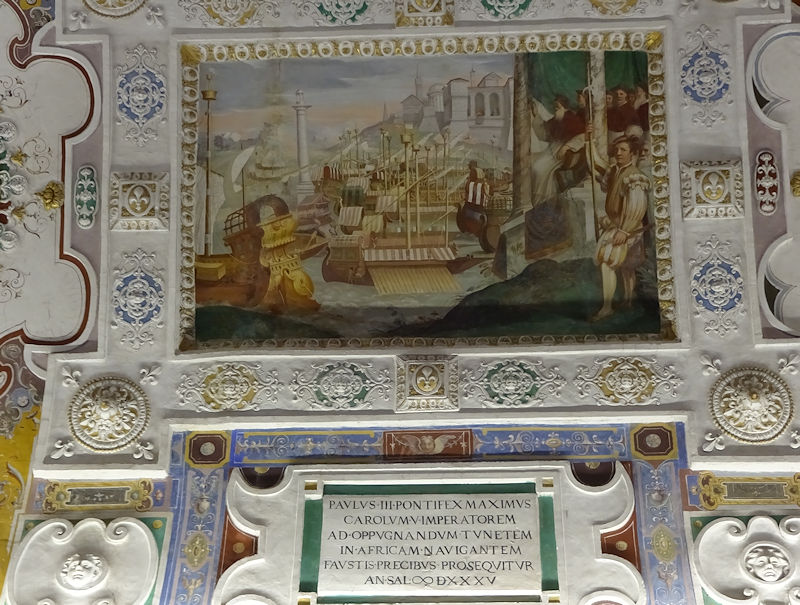
In 1535, Pope Paul III contributed galleys to the Emperor's successful naval raid on Tunis led by admiral Andrea Doria (though he had wanted them to attack Istanbul instead).

A sightseer in the Summer Apartments (once filled with tapestries and wall hangings, which were sold off by the family in 1681)

A squint out the window at the gardens behind the villa -- we've been instructed that they're off limits today because of the high winds.
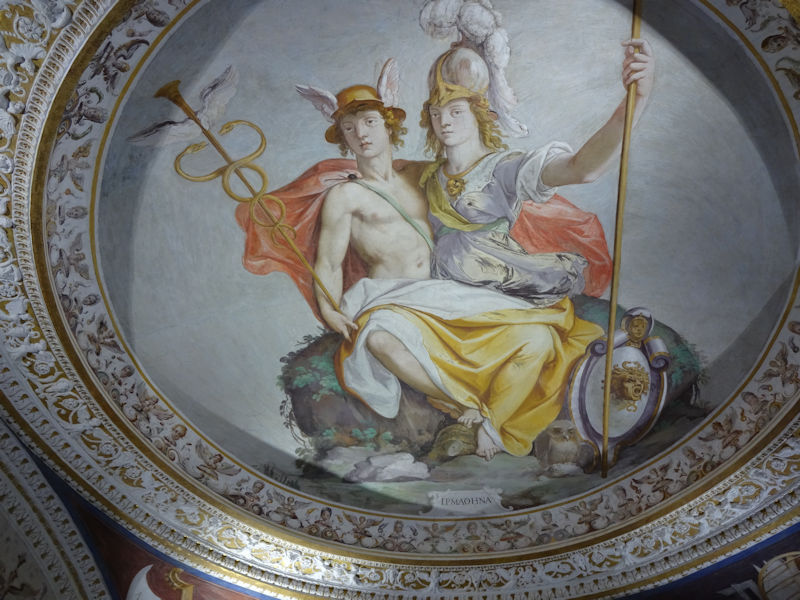
In Cardinal Alessandro's private study, the Room of Hermathena, here's a strange Hermes and Athena as one figure -- the union of eloquence and wisdom (we've been told), by Federico Zuccari
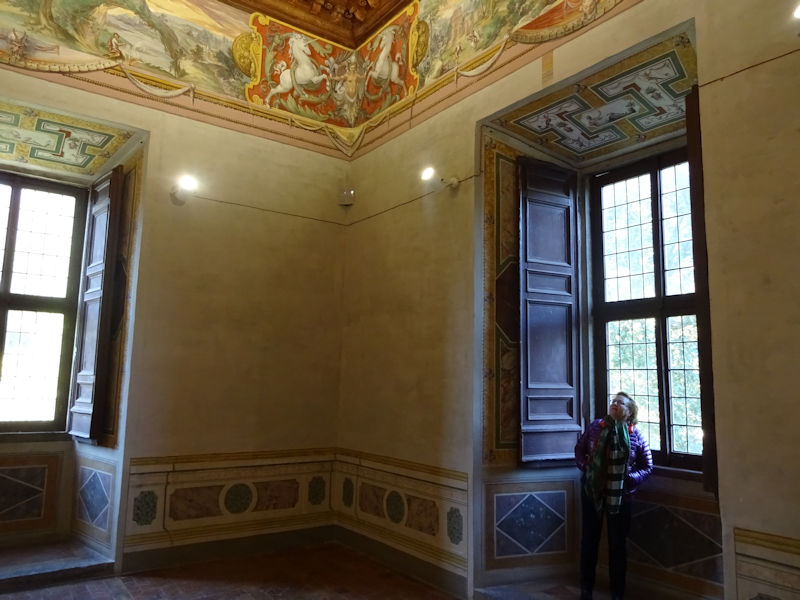
Viewing the fine ceiling in the Tower Room . . .

. . . created by "Marco from Caprarola"
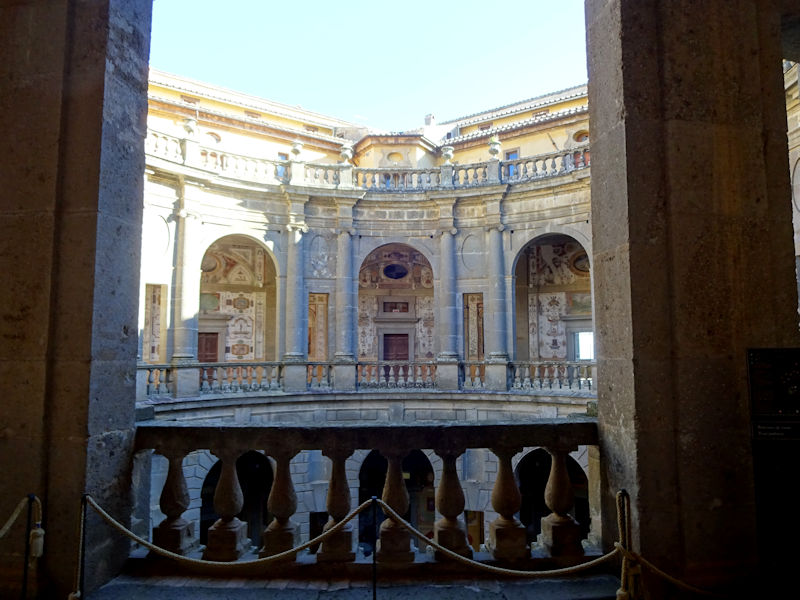
Cardinal Alessandro, when he died in 1589, bequeathed most of his properties and his huge collection of Roman sculpture to his brother Ottavio's side of the family, in the person of Alexander the 3rd Duke of Parma, the military commander of the Spanish armies in the Netherlands at the time. The last Duke of Parma died in 1731 without direct heirs and the Farnese inheritance passed via his niece, the Queen of Spain, to her son, later King Carlos III. The Spanish Bourbons were lords of southern Italy, based in Naples, and most of what wasn't nailed down in the Farnese properties was carried off to Naples. The villa was taken over by the Savoyard heirs to the Kingdom of Italy in the 19th century and came into the possession of the Italian state in 1941.

The Room of World Maps, featuring the Holy Land, Italy, and the continents as they were understood in 1574. In 1578 a big dinner was held for Pope Gregory XIII in this room, and he went off and ordered up a similar room in the Vatican.

A little shaky on the New World, understandably

Surprisingly good for Africa
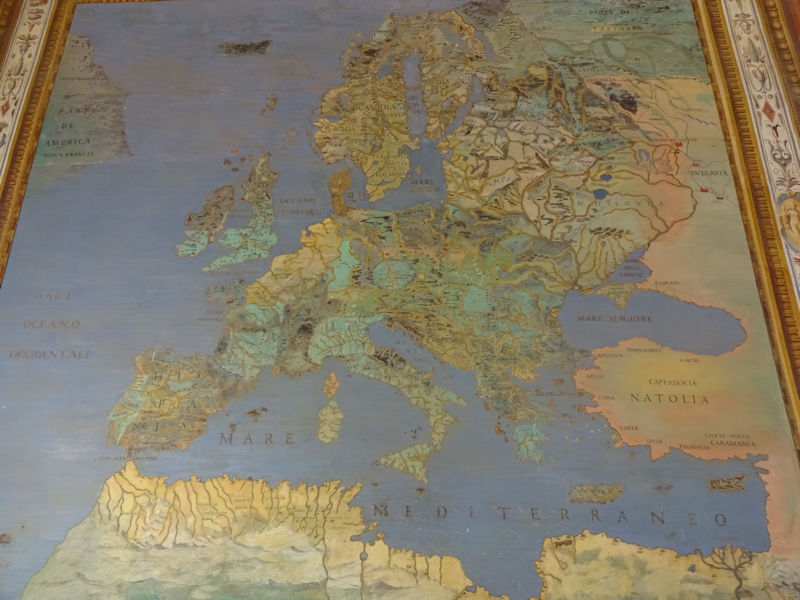
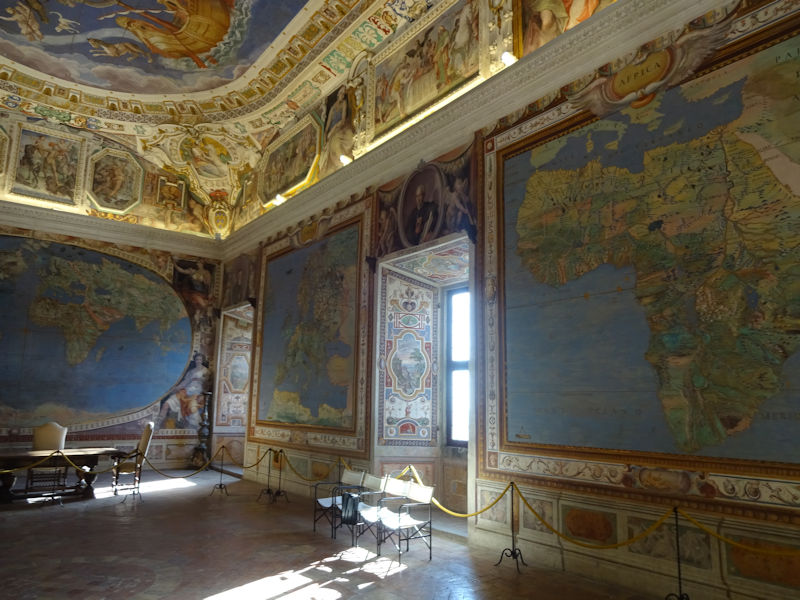

Chilly wind or not, we have to get a look at this famous garden.

Corner bastions from the original fortress design, and the moat, now dry

The garden is said to have been widely imitated in its time, but we won't get to see very much of it.
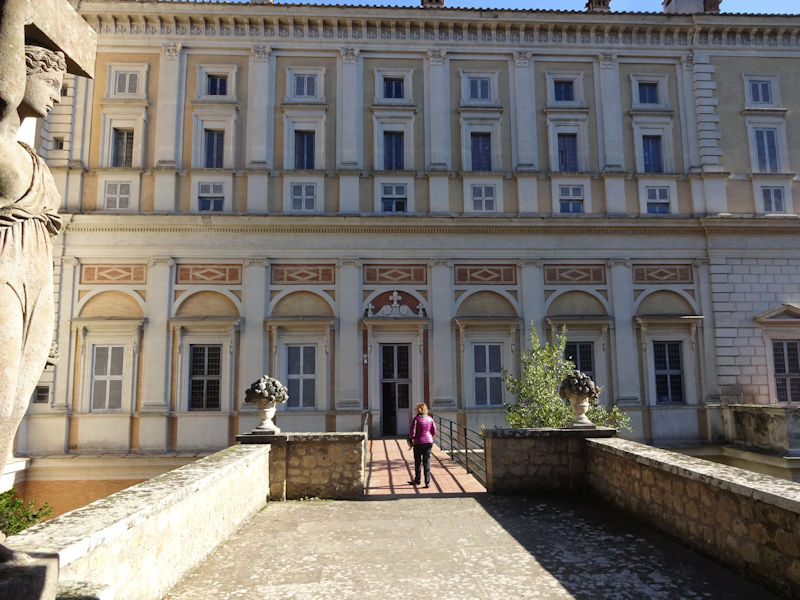
Back inside, quick
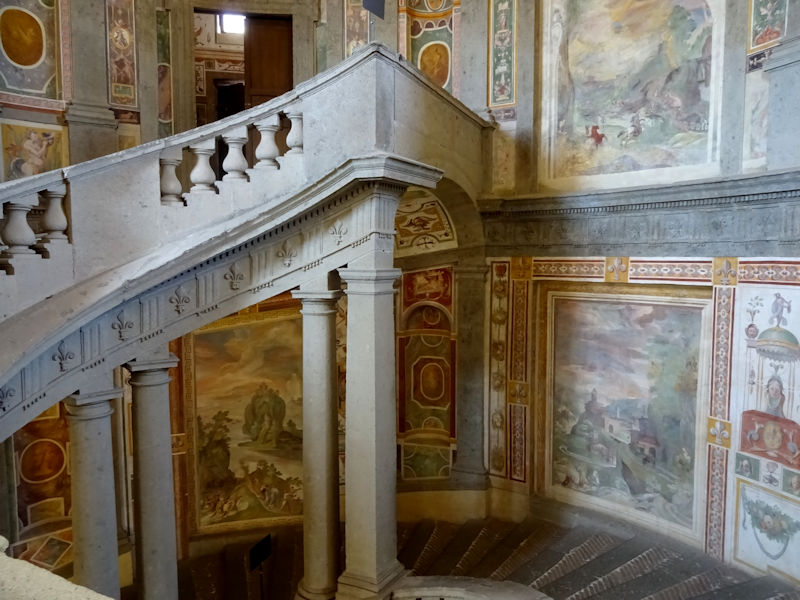
Back down the Royal Staircase

The countryside roundabout
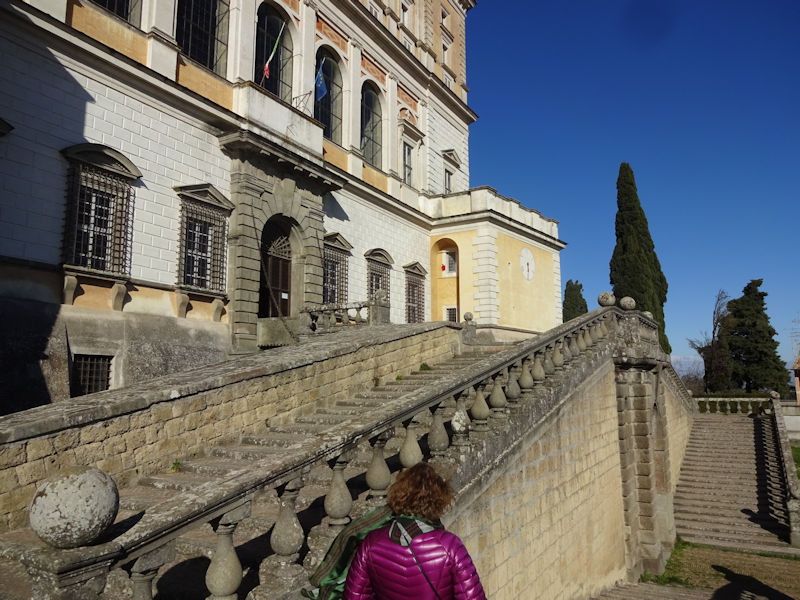
We're moving on now, to Bracciano and the Castello Orsini-Odescalchi.









































































